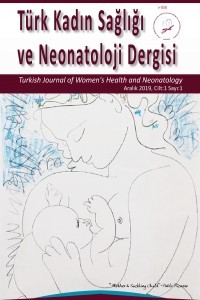Duktus Venozus Agenezisinin Prenatal Tanısı: Olgu Serisi
Duktus venozus agenezisi, intrahepatik drenaj, ekstrahepatik drenaj, umblikal ven, portal sistem
Prenatal Diagnosis of Ductus Venosus Agenesis: Case Series
Ductus venosus agenesis, intrahepatic drainage, extrahepatic drainage, umblical vein, portal system,
___
- Referans1 Kiserud T, Acharya G. The fetal circulation. Prenat Diagn. 2004;24:1049–59.
- Referans2 Born M. The Ductus Venosus. Rofo. 2021 May;193(5):521-526. English, German Referans3 Strizek B, Zamprakou A, Gottschalk I, Roethlisberger M, Hellmund A, Müller A, Gembruch U, Geipel A, Berg C. Prenatal Diagnosis of Agenesis of Ductus Venosus: A Retrospective Study of Anatomic Variants, Associated Anomalies and Impact on Postnatal Outcome. Ultraschall Med. 2019 Jun;40(3):333-339
- Referans4 Edelstone DI, Rudolph AM, Heymann MA. Liver and ductus venosus blood flows in fetal lambs in utero. Circ Res 1978; 42: 426–33
- Referans5 Huisman TW, Stewart PA, Wladimiroff JW. Ductus venosus blood flow velocity waveforms in the human fetus—a Doppler study Ultrasound Med Biol 1992; 18: 33–7
- Referans6 Hecher K, Campbell S. Characteristics of fetal venous blood flow under normal circumstances and during fetal disease. Ultrasound Obstet Gynecol 1996; 7: 68–83
- Referans7 Acherman RJ, Evans WN, Galindo A et al. Diagnosis of absent ductus venosus in a population referred for fetal echocardiography: association with a persistent portosystemic shunt requiring postnatal device occlusion. J Ultrasound Med 2007; 26: 1077–1082
- Referans8 Berg C, Kamil D, Geipel A et al. Absence of ductus venosus-importance of umbilical venous drainage site. Ultrasound Obstet Gynecol 2006; 28: 275–281
- Referans9 Contratti G, Banzi C, Ghi T et al. Absence of the ductus venosus: report of 10 new cases and review of the literature. Ultrasound Obstet Gynecol 2001; 18: 605–609
- Referans10 Morgan G, Superina R. Congenital absence of the portal vein: two cases and a proposed classification system for portasystemic vascular anomalies. J Pediatr Surg 1994; 29: 1239–41
- Referans11 Grazioli L, Alberti D, Olivetti L, Rigamonti W, Codazzi F, Matricardi L, Fugazzola C, Chiesa A. Congenital absence of portal vein with nodular regenerative hyperplasia of the liver. Eur Radiol 2000; 10 820–5
- Referans12 Souka AP, Krampl E, Bakalis S, Heath V, Nicolaides KH. Outcome of pregnancy in chromosomally normal fetuses with increased nuchal translucency in the first trimester. Ultrasound Obstet Gynecol 2001; 18: 9–17
- Referans13 Gembruch U, Baschat AA, Caliebe A, Gortner L. Prenatal diagnosis of ductus venosus agenesis: a report of two cases and review of the literature. Ultrasound Obstet Gynecol 1998; 11: 185–9
- Referans14 Achiron R, Gindes L, Gilboa Y et al. Umbilical vein anomaly in foetuses with Down syndrome. Ultrasound Obstet Gynecol 2010; 35: 297–301
- Referans15 Weissmann-Brenner A, Zalel Y. Umbilical vein insertion into the inferior vena cava: an ominous sign of chromosomal abnormalities? J Ultrasound Med 2014; 33: 2207–2210
- Başlangıç: 2019
- Yayıncı: Sağlık Bilimleri Üniversitesi Etlik Zübeyde Hanım Kadın Hastalıkları Eğitim ve Araştırma Hastanesi
Rabia Merve PALALIOGLU, Halil İbrahim ERBIYIK
Sezaryen Doğumda Gelişmiş Cerrahi Sonrası İyileşme Programları: Literatür Taraması
Tuğba KINAY, Müjde Can İBANOĞLU, Yaprak USTUN
Mehmet Alican SAPMAZ, İlknur SAYAR, Ece YİĞİT, Tuncay KÜÇÜKÖZKAN
Okan OKTAR, Hande Esra KOCA, Candost HANEDAN, Caner KOSE, Fulya KAYIKÇIOĞLU, Caner ÇAKIR
Tuğba KINAY, Şule ATALAY MERT, Caner KOSE, Sinan KARADENİZ, Yaprak USTUN
Hüsniye YÜCEL, İstemi Han ÇELİK, Ayşen Sumru KAVURT, Beyza ÖZCAN, Semih SANDAL, Ahmet Yağmur BAŞ, Nihal DEMİREL
Duktus Venozus Agenezisinin Prenatal Tanısı: Olgu Serisi
Neval ÇAYÖNÜ KAHRAMAN, Ozge YUCEL CELİK, Cantekin İSKENDER
Koenzim Q10: Güncel Genel Bakış
Kadriye ERDOĞAN, Melahat Sedanur MACİT, Nazlı Tunca ŞANLIER, Yaprak USTUN
